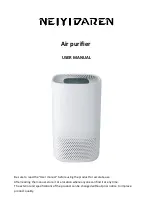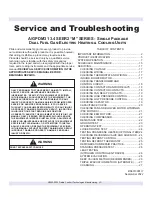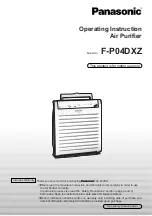
6
6. Trouble Shooting
Having trouble?
Here is the solution. (Unit is operating normally.)
Airflow direction changes during operation or airflow direction cannot be
set.
■
During cooling mode, the vanes automatically move to the horizontal
(down) position after 1 hour when the down (horizontal) airflow direc-
tion is selected. This is to prevent water from forming and dripping
from the vanes.
■
During heating mode, the vanes automatically move to the horizontal
airflow direction when the airflow temperature is low or during defrost-
ing mode.
When the airflow direction is changed, the vanes always move up and
down past the set position before finally stopping at the position.
■
When the airflow direction is changed, the vanes move to the set po-
sition after detecting the base position.
A flowing water sound or occasional hissing sound is heard.
■
These sounds can be heard when refrigerant is flowing in the air con-
ditioner or when the refrigerant flow is changing.
A cracking or creaking sound is heard.
■
These sounds can be heard when parts rub against each due to ex-
pansion and contraction from temperature changes.
The room has an unpleasant odor.
■
The indoor unit draws in air that contains gases produced from the
walls, carpeting, and furniture as well as odors trapped in clothing,
and then blows this air back into the room.
A white mist or vapor is emitted from the indoor unit.
■
If the indoor temperature and the humidity are high, this condition
may occur when operation starts.
■
During defrosting mode, cool airflow may blow down and appear like
a mist.
Water or vapor is emitted from the outdoor unit.
■
During cooling mode, water may form and drip from the cool pipes
and joints.
■
During heating mode, water may form and drip from the heat ex-
changer.
■
During defrosting mode, water on the heat exchanger evaporates and
water vapor may be emitted.
The operation indicator does not appear in the wired remote controller
display. (*1)
■
Turn on the power switch. “ ” will appear in the wired remote controller
display.
“
” appears in the wired remote controller display. (*1)
■
During central control, “
” appears in the wired remote controller
display and air conditioner operation cannot be started or stopped us-
ing the wired remote controller.
When restarting the air conditioner soon after stopping it, it does not op-
erate even though the ON/OFF button is pressed.
■
Wait approximately three minutes.
(Operation has stopped to protect the air conditioner.)
Air conditioner operates without the ON/OFF button being pressed. (*1)
■
Is the on timer set?
Press the ON/OFF button to stop operation.
■
Is the air conditioner connected to a central wired remote controller?
Consult the concerned people who control the air conditioner.
■
Does “
” appear in the wired remote controller display?
Consult the concerned people who control the air conditioner.
■
Has the auto recovery feature from power failures been set?
Press the ON/OFF button to stop operation.
Air conditioner stops without the ON/OFF button being pressed. (*1)
■
Is the off timer set?
Press the ON/OFF button to restart operation.
■
Is the air conditioner connected to a central wired remote controller?
Consult the concerned people who control the air conditioner.
■
Does “
” appear in the wired remote controller display?
Consult the concerned people who control the air conditioner.
Wired remote controller timer operation cannot be set. (*1)
■
Are timer settings invalid?
If the timer can be set,
,
, or
appears in
the wired remote controller display.
“PLEASE WAIT” appears in the wired remote controller display. (*1)
■
The initial settings are being performed. Wait approximately 3 min-
utes.
An error code appears in the remote controller display.
■
The protection devices have operated to protect the air conditioner.
■
Do not attempt to repair this equipment by yourself.
Turn off the power switch immediately and consult your dealer. Be
sure to provide the dealer with the model name and information that
appeared in the remote controller display.
Draining water or motor rotation sound is heard.
■
When cooling operation stops, the drain pump operates and then
stops. Wait approximately 3 minutes.
Noise is louder than specifications.
■
The indoor operation sound level is affected by the acoustics of the
particular room as shown in the following table and will be higher than
the noise specification, which was measured in an echo-free room.
High sound-
absorbing rooms Normal rooms
Low sound-ab-
sorbing rooms
Location
examples
Broadcasting
studio, music
room, etc.
Reception
room, hotel
lobby, etc.
Office, hotel
room
Noise levels
3 to 7 dB
6 to 10 dB
9 to 13 dB
*1: Only for wired remote controller.
Содержание Mr.Slim SLZ-KA09
Страница 23: ......







































